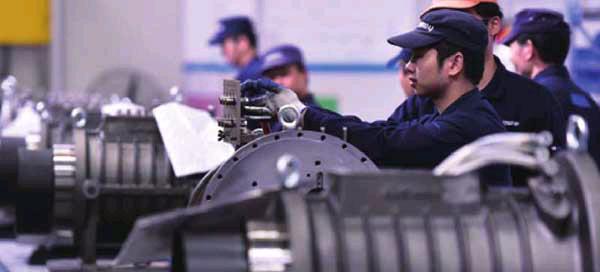Investment Push
2016-08-17ByWangJun
By+Wang+Jun
In the first half of this year, Chinas private investment in fixed assets totaled nearly 15.88 trillion yuan ($2.37 trillion), according to the National Bureau of Statistics (NBS) on July 15. This accounted for 61.5 percent of the total investment. The growth rate, however, slowed further to 2.8 percent in nominal terms from 3.9 percent in the first five months and 5.2 percent from January through April. In the same period of 2015, the same index stood at 11.4 percent.
The consistent decline drew concerns from policymakers even before the latest statistics were unveiled.
Xu Shaoshi, Chairman of the National Development and Reform Commission(NDRC), said at the Summer Davos Forum in Tianjin in late June that the State Council, Chinas cabinet, had sent groups to inspect local authorities implementation of preferential policies for private investors.
On July 4, the State Council issued a circular urging greater effort to boost investment by non-public sectors.
Growth slowdown
The private economy makes up about 60 percent of Chinas GDP and creates 80 percent of new jobs in cities. It accounts for over 60 percent of Chinas total fixed assets investment and has become a crucial stabilizer of the economy, said the State Council circular.
After the global financial crisis in 2008, the growth of Chinas private fixed assets investment dropped significantly, but it recovered soon after the Chinese Government launched a massive economic stimulus package worth 4 trillion yuan ($586 billion at the then exchange rate). However, the increase has slowed down again since 2012, and so far in 2016, it is even slower than the growth of total fixed assets investment, a very rare occurrence in the past decade. According to NBS figures, in the first six months of this year, total fixed assets investment in China went up 9 percent year on year in nominal terms, while private investment rose 2.8 percent.
Xu said that there are three major reasons behind the slower growth of private investment; namely, an unfavorable market environment, insufficient incentives and excessive industrial production capacity. “First of all, as global economic growth slows down, demand in domestic and foreign markets has declined, curbing investment activities,” he said. “In addition, some policies in support of private investment are poorly implemented. And last, in industries suffering from overcapacity, some small and medium-sized enterprises (SMEs) are ill-prepared for transformation.”
Sheng Laiyun, a spokesman for the NBS, attributed the decrease partly to the adjustment of the overall economic structure. Around 50 percent of private investment used to go to the manufacturing sector. As the Chinese economy has entered a new stage of transformation, traditional industries need reorganization to reduce overcapacity. Due to weak market demand and the falling prices of industrial products, enterprises are less willing to invest, which is the primary factor behind the slowdown of private investment growth, Sheng said at a press conference on July 15. However, he stressed that as the ongoing economic adjustment is of vital importance to industrial restructuring, an appropriate slowdown of investment growth is conducive to reforming traditional industries.
“Most private investment has been placed in the manufacturing sector, but currently this sector is plagued by severe excess capacity. The sluggish global economy and growing protectionism have also weakened overseas demand,”said Han Zhifeng, Deputy Director of the NDRCs Department of Fixed Assets Investment.
In the meantime, as non-performing loans rise rapidly amid slowing economic growth, the banking sector has tightened credit supplies to SMEs in recent months to avoid risks, which also diminishes private investment. “Small private enterprises that need to upgrade and transform often have difficulties in financing. Consequently, most of them have to readjust their investment strategies or slow down the investment process,” Han said.
Wu Qi, a research fellow with the Research Institute of China Minsheng Banking Corp. Ltd., said that both longand short-term factors have curbed private investment growth. In the short-term, the cancellation of preferential taxation policies for new projects, slow progress in addressing overcapacity and huge property inventory, as well as fast growth in non-performing loans in the banking sector, explain the significant drop of private businesses spending on fixed assets, he added.
Favorable policies
Reports from an extensive survey on private investment across the country revealed prob-lems in some regions and sectors, said the State Council circular. For instance, the financing problems of some private enterprises have been exacerbated by high expenses and lack of support compared with state-owned enterprises. Business costs and the tax burden on private enterprises are also high.
In response, the Central Government required local governments to further reduce administrative approval requirements for private firms and improve services. The Administrative Approval Reform Office of the State Council will carry out an inspection concerning those reforms in the second half of this year in conjunction with relevant departments.
To create a fair business environment, the State Council pledged to speed up the introduction of a negative list approach on market access, which will allow investment in all activities except those that are listed as prohibited or restricted. More sectors will be opened to private investors as soon as possible, such as civil airports and oil and gas exploration and exploitation, and local governments will cancel additional and discriminatory conditions against private enterprises in infrastructure and public utility sectors. Effective measures must be formulated to protect fair competition in industries such as healthcare and education, the circular added.
In addition, the State Council demanded that steps be taken to mitigate some of the challenges faced by private enterprises when securing loans, such as high charges. Financial institutions should strictly implement the policies and measures that support the development of the real economy, the circular said.
Local governments have also been required to actively promote the improvement of financial services, expand financing channels for private enterprises and lower financing costs.
Gao Peiyong, head of the National Academy of Economic Strategy at the Chinese Academy of Social Sciences, suggested that in the second half of this year, the government should, through supplyside structural reform, steadily cut excessive capacity, advance the transformation and upgrading of traditional industries, boost emerging industries, and further alleviate the tax burden on enterprises.
Wu said that the government must take a market-oriented approach to stimulate private investment, accelerate the transformation of government functions, give enterprises a full role as market players and allow the market to play a decisive role in resource allocation. The government should also encourage financial institutions to innovate services in sync with the demands of private enterprises.
“Compared with government-led investment, private investment is more marketoriented and efficient,” Wu said. “Boosting private investment and better serving private enterprises have become increasingly important in maintaining sound and sustainable economic growth in China.”
